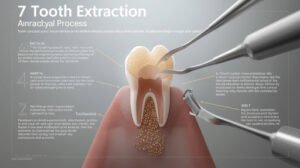How Long Does It Take to Extract a Tooth? Your Complete Procedure & Recovery Guide
You’re sitting in the dental chair, heart pounding a little, and the question pops into your head: “Just how long does it take to extract a tooth?” It’s a universal source of anxiety. Whether it’s a stubborn wisdom tooth acting up or a broken molar beyond repair, the unknown can be the most frightening part.
The truth is, there’s no single answer. Asking how long does it take to extract a tooth is like asking how long it takes to cook a meal—it depends entirely on the recipe and the ingredients. A simple extraction is a quick sauté, while a surgical one is a slow roast.
In this comprehensive guide, we’ll not only answer how long does it take to extract a tooth but also walk you through what happens during each minute of the procedure and what to expect during your recovery. Let’s demystify the process together.
The Two Types of Tooth Extractions: A Tale of Two Procedures
The single biggest factor determining your time in the chair is the type of extraction you need. Understanding this distinction is the first step to answering how long does it take to extract a tooth.
Simple Extraction
A simple extraction is performed on a tooth that is visible in the mouth, has a fully formed root, and is relatively easy to access.
- The Process: Your dentist will use a tool called an elevator to loosen the tooth, followed by forceps to rock it back and forth until it lifts freely from its socket.
- Anaesthesia: Local aesthetic is used to numb the area completely. You’ll be awake but should feel no pain, only pressure.
- Common Candidates: Severely decayed teeth, loose teeth from advanced gum disease, or teeth removed for orthodontic reasons.
Surgical Extraction
A surgical extraction is more complex. It’s required when a tooth isn’t easily accessible.
- The Process: This may involve making a small incision in the gum, removing a tiny amount of bone, or sectioning the tooth into pieces for removal. Your dentist or oral surgeon might use sutures (stitches) to close the site.
- Anaesthesia: This can be done under local anaesthesia, but sedation options (like IV sedation or nitrous oxide) are also common for patient comfort.
- Common Candidates: Impacted wisdom teeth (especially lower ones), teeth with severely curved or complex roots, or teeth that have broken off at the gum line.
So, How Long Does It Take to Extract a Tooth? The Clock Breakdown
Let’s get to the heart of the matter. The total time you spend in the operatory is more than just the physical removal of the tooth. Here’s a minute-by-minute breakdown.
The Timeline of a Simple Extraction (20-40 Minutes Total)
When people ask how long does it take to extract a tooth simply, they are often pleasantly surprised.
- Preparation & Anaesthesia (10-15 minutes): This is often the longest part. The dentist will review the procedure, apply a topical gel to numb your gum, and then administer the local aesthetic. Waiting for the area to become fully numb is crucial and takes a few minutes.
- The Actual Tooth Removal (5-10 minutes): Once you’re numb, the physical extraction itself is very quick. The rocking and pressure last only a few minutes, and the tooth comes out.
- Cleaning & Aftercare (5 minutes): The dentist will clean the socket, place a piece of gauze over it, and give you bite-down pressure instructions.
In total, for a simple extraction, the active procedure time is typically under 10 minutes, with the entire appointment lasting about 30 minutes.
The Timeline of a Surgical Extraction (45-90+ Minutes Total)
The question of how long does it take to extract a tooth surgically has a much wider range.
- Preparation & Anaesthesia (15-20 minutes): This step is more involved, especially if sedation is used. Establishing the correct level of sedation and ensuring you are completely numb takes time.
- The Surgical Procedure Itself (20-60 minutes): This is the variable part. The time required to extract a tooth surgically depends on:
- Impaction Level: A fully bony impaction takes longer than a soft tissue impaction.
- Tooth Position: Is it angled? Is it near a nerve?
- Root Complexity: Fused roots are easier than hooked, divergent roots.
- Closing the Site (5-10 minutes): The surgeon will irrigate the socket, place sutures if needed, and apply gauze.
For a single surgical extraction, you can expect the entire process to take between 45 and 90 minutes. Multiple surgical extractions (like all four wisdom teeth) will, of course, take longer.
Also Read This :How Long Does It Take to Extract a Tooth
Factors That Influence How Long It Takes to Extract a Tooth
Beyond the basic type, several other factors can influence the clock.
| Factor | Impact on Procedure Time |
| Tooth Location | Front teeth with single, conical roots are faster than back molars with multiple, curved roots. |
| Patient Age | In older patients, bone can be more brittle and teeth can be more fused to the jaw, potentially complicating removal. |
| Previous Dental Work | A tooth with a large crown or root canal can be more fragile and prone to breaking upon extraction. |
| Infection or Abscess | The presence of an active infection can sometimes make Anaesthesia Original aesthetic is used to numb the area fully. |
| Surgeon’s Experience | An experienced oral surgeon or general dentist who performs extractions regularly will often be more efficient. |
Beyond the Clock: What to Expect During the Extraction Process

Knowing what’s happening can ease anxiety. Here’s a play-by-play.
The Sensation of Pressure: This is the most common thing patients report. You will not feel sharp pain, but you will feel firm pushing, rocking, and pressure. It’s a strange sensation, but it is normal.
The Sounds: You will hear sounds—the crunching or cracking as the tooth loosens from its ligament, the suction device clearing saliva. Don’t be alarmed; it often sounds louder inside your head than it actually is.
Communication is Key: You are in control. If you feel any sharp pain, raise your hand. The dentist will stop and administer more aesthetic. Your comfort is their priority.
Your Road to Recovery: A Guided Timeline
The procedure is only half the journey. Understanding recovery is just as important as knowing how long does it take to extract a tooth.
The First 24 Hours: The Crucial Period
- Bleeding: Expect some oozing. Bite down firmly on the gauze for 30-60 minutes. Change it as directed.
- Swelling: This is normal, especially after surgical extractions. Use an ice pack on your cheek (20 minutes on, 20 minutes off) to minimize it.
- Pain Management: Take prescribed painkillers or over-the-counter ibuprofen as soon as you feel the numbness wearing off. Don’t wait for the pain to become severe.
- Diet: Stick to cool, soft foods (yogurt, pudding, mashed potatoes). Avoid straws, spitting, and smoking, as the suction can dislodge the blood clot and cause a painful dry socket.
The First Week: Healing in Motion
- Swelling usually peaks at 48 hours and then subsides.
- Brushing: Gently brush your teeth, but avoid the extraction site.
- Diet: You can gradually reintroduce softer solid foods.
- Sutures: If you have dissolvable stitches, they will begin to disappear. Non-dissolvable ones are removed after about a week.
Long-Term Healing: The Socket Closes
The soft tissue heals in about 3-4 weeks, but it can take several months for the underlying bone to fill in completely. The American Dental Association provides excellent patient resources on what to expect after an extraction.
When to Call Your Dentist
While some discomfort is normal, be aware of signs of complication:
- Uncontrolled bleeding.
- Throbbing pain that isn’t relieved by medication (a potential sign of dry socket).
- Signs of infection, such as fever, pus, or increasing swelling after 2-3 days.
- Numbness that persists long after the local aesthetic should have worn off.
Conclusion: Time Well Spent for Long-Term Health
So, the next time someone asks you, “how long does it take to extract a tooth? “you can confidently tell them it’s a diapason. . A simple removal is a brief, straightforward event, while a surgical procedure is a more involved investment in your oral health.
Ultimately, the 20 to 90 minutes you spend in the chair is a small price to pay for the relief from pain and the prevention of future dental problems. The key is to choose a skilled and trusted dental professional, communicate your concerns, and follow their aftercare instructions to the letter.
Also Read More: How Long Does It Take to Extract a Tooth
Frequently Asked Questions
What is a “dry socket” and how do I avoid it?
A dry socket (alveolar osteitis) is the most common complication after an extraction. It occurs when the protective blood clot in the tooth socket becomes dislodged or dissolves prematurely, exposing the underlying bone and nerves. This can cause severe, throbbing pain that often radiates to your ear.
To avoid it, strictly follow your dentist’s aftercare instructions: avoid using straws, spitting forcefully, or smoking for at least 3-5 days after your procedure. These conduct produce suction that can pull the clot out. Also, stick to soft foods and avoid disturbing the site with your tongue or fingers.
I’m feeling very anxious. What are my options for sedation?
Dental anxiety is extremely common, and modern dentistry has several solutions. For simple extractions, local aesthetic is usually sufficient. However, for surgical procedures or for highly anxious patients, options include:
- Nitrous Oxide (“Laughing Gas”): A mild sedative you breathe through a mask that helps you relax; it wears off quickly.
- Oral Sedation: A pill taken before the procedure that induces a state of deep relaxation.
- IV Sedation: Administered directly into the bloodstream for a deeper level of sedation, often used for complex surgical extractions.
Discuss your anxiety with your dentist beforehand so they can recommend the best option for you.
How soon after the extraction can I eat and drink?
You can drink cool water immediately after the procedure, but be careful not to swish it around. For eating, wait until the numbness in your mouth has completely worn off (usually 2-4 hours) to avoid accidentally biting your cheek or tongue. For the first 24-48 hours, consume only cool or lukewarm, soft foods like yogurt, applesauce, smoothies (eaten with a spoon, no straw!), and mashed potatoes.
When can I go back to work or school?
This depends on the complexity of your extraction and your body’s response. After a simple extraction, many people feel fine returning to work or school the next day. For a surgical extraction, especially under sedation, it’s wise to plan for 1-2 days of rest. If your job is physically demanding, you may need more time. Always listen to your body and follow your dentist’s specific recommendations.
What is the white material I see in the socket a few days after my extraction?
Don’t be alarmed! This is a normal sign of healing. The white material is not food or pus; it is fibrin, a protein that forms a protective layer over the healing wound. It is part of the body’s natural healing process and protects the new tissue growing underneath. It may look a bit like a scab and is a positive sign that your socket is mending properly. Avoid picking at it.











